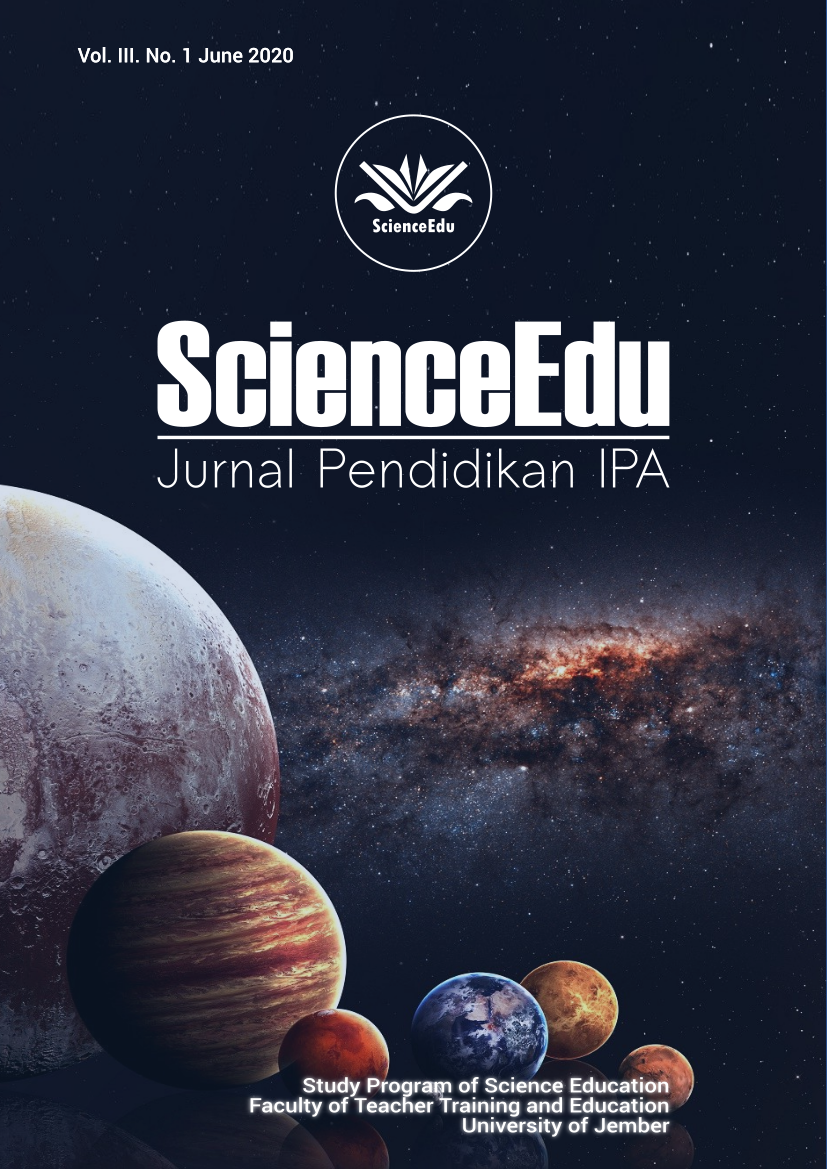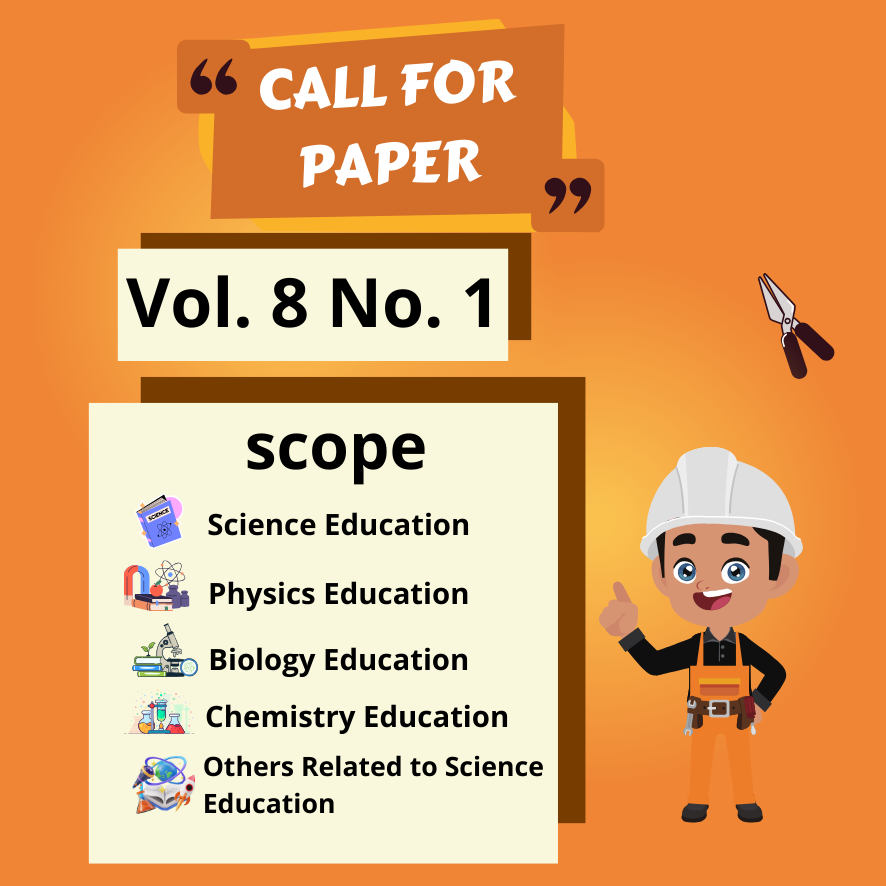THE EFFECTIVENESS OF GUIDED INQUIRY LEARNING ASSISTED BY PhET SIMULATION TO IMPROVE THE CAPABILITY OF REPRESENTATION IMAGE OF SCIENCE STUDENT IN JUNIOR HIGH SCHOOL
DOI:
https://doi.org/10.19184/se.v3i1.17492Keywords:
Effectiveness, Guided Inquiry, PhET Simulation, Image RepresentationAbstract
This study aims to describe the understanding of science concepts of junior high school students in the form of image representation through guided inquiry learning assisted with simulated PhET. This type of research is quantitative descriptive research. The study was conducted at SMP Negeri 2 Genteng. The research subjects were all students of class VIII A and VIII D with a total of 64 student respondents. The collection of data using the test, interview, observation, and documentation techniques. The data analysis technique is to use the Normalized N-Gain test to describe the ability of students' image representation. The results of data analysis showed an increase in understanding of the concept of science in the form of image representation with a value of g = 0.7. In conclusion, that the guided inquiry learning model assisted by the PhET simulation can improve the ability of students' science concepts in the form of Image Representation with high categories, which means that this learning is very effective.
Downloads
References
Arda, et al. (2013). Development of Interactive Computer-Based Learning Media For Junior High School Students Grade VIII. Science Partners E-Journal, 3(1), 69–77.
Astuti, Y., & Setiawan, B. (2013). Development of student worksheets (LKS) based on a guided inquiry approach in cooperative learning on heat material. Indonesian Natural Sciences Education Journal, 2(1), 88–92. https://doi.org/10.15294/jpii.v2i1.2515
Damayanti, S., Mahardika, I., & Indrawati, I. (2016). Application of Discovery Learning Model Assisted by Macromedia Flash Animation Media Accompanied by LKS Integrated with Multirepresentations in Physics Learning in High School. Journal of Physics Learning, 4(4), 357-364–364.
Hajrin, M., Sadia, W., & Gunandi, IGA (2019). The effect of guided inquiry learning models on students' critical thinking skills in physics learning in class X IPA of SMA Negeri. JPPF. 9 (1), 63–74.
Hake, R. (1999). Analyzing Change / Gain Score. Indiana University.
Indrawati. (2011). Learning models. University of Jember.
Jaenudin (2008). The Effect of Contextual Approaches on the Mathematical Representation Ability of Various Middle School Students. Department of Mathematics Education, Indonesian University of Education.
Neria, D., & Amit, M. (2004). Students' preferences of non-algebraic representations in mathematical communication. Proceedings of the 28th Conference of the International Group for the Psychology of Mathematics Education, 3, 409–416.
Prahani, BK, WW, S., & Yuanita, L. (2017). Development of Guided Inquiry Model Physics Learning Tools to Practice the Multi-Representative Abilities of High School Students. JPPS (Journal of Science Education Research), 4(2), 503. https://doi.org/10.26740/jpps.v4n2.p503-517
Prihatni, Y., Kumaidi, K., & Mundilarto, M. (2016). Development of cognitive diagnostic instruments in science subjects in junior high school. Journal of Educational Research and Evaluation. 20 (1), June 2016 (111-) Online: http://journal.uny.ac.id/index.php/jpep. Journal of Educational Research and Evaluation, 20 (1), 111–125.
Prasetyawati, IW, Subiki. & Budiarso, USA (2019). the effect of guided inquiry-based Ix with the snakes and ladders game on the motivation and learning outcomes of high school students in the district of Jember. Journal of Physical Education. Vol 8 (3), 137–143.
Rais, AA, Hakim, L., & Sulistiawati, S. (2020). Understanding of Student Concepts through the PhET Simulation-Guided Guided Inquiry Model. Physics Education Research Journal, 2(1), 1. https://doi.org/10.21580/perj.2020.2.1.5074
Rizky, G., Tomo, D., & Haratua, T. (2014). Multirepresentation Ability of High School Students in Solving Newton's Law Questions. Journal of Education and Learning, 3(8), 1–10. http://jurnal.untan.ac.id/index.php/jpdpb/article/view/6733/6967
Sumarauw, JM, Ibrahim, M., and Prastowo, T. (2017). Development of guided inquiry-based learning tools assisted with PhET simulation in natural science learning. Jurnal Education Research. 34 (1), 978–979.
Taufik, M., Sukmadinata, NS, Abdulhak, I., & Tumbelaka, BY (2010). Design Learning Models to Improve Problem Solving Ability in Learning Science (Physics) Middle School in Bandung. Periodical Physics, 13(2), 31–44.
Trianto. (2010). Designing Innovative-Progressive Learning Models. Kencana.
Widyawati, A., & Prodjosantoso, AK (2015). Development of Ipa Comic Media to Increase Learning Motivation and Character of Junior High School Students. Journal of Science Education Innovation, 1(1), 24. https://doi.org/10.21831/jipi.v1i1.4529
Yuwono, G., Mahardika, I., & Gani, A. (2016). The Effect of Guided Inquiry Learning Model on Student Physics Learning Outcomes (Verbal Representation Ability, Images, Mathematics, and Graphics) in High School. Journal of Physics Learning in Jember University, 5(1), 60-65.



